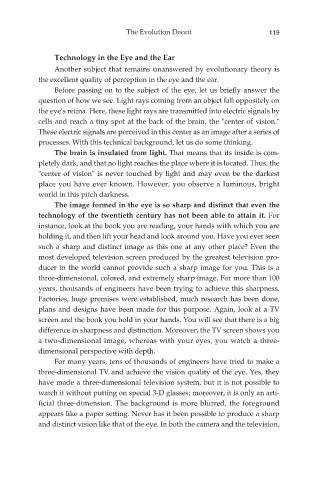Page 121 - Deep Thinking
P. 121
The Evolution Deceit 119
Technology in the Eye and the Ear
Another subject that remains unanswered by evolutionary theory is
the excellent quality of perception in the eye and the ear.
Before passing on to the subject of the eye, let us briefly answer the
question of how we see. Light rays coming from an object fall oppositely on
the eye's retina. Here, these light rays are transmitted into electric signals by
cells and reach a tiny spot at the back of the brain, the "center of vision."
These electric signals are perceived in this center as an image after a series of
processes. With this technical background, let us do some thinking.
The brain is insulated from light. That means that its inside is com-
pletely dark, and that no light reaches the place where it is located. Thus, the
"center of vision" is never touched by light and may even be the darkest
place you have ever known. However, you observe a luminous, bright
world in this pitch darkness.
The image formed in the eye is so sharp and distinct that even the
technology of the twentieth century has not been able to attain it. For
instance, look at the book you are reading, your hands with which you are
holding it, and then lift your head and look around you. Have you ever seen
such a sharp and distinct image as this one at any other place? Even the
most developed television screen produced by the greatest television pro-
ducer in the world cannot provide such a sharp image for you. This is a
three-dimensional, colored, and extremely sharp image. For more than 100
years, thousands of engineers have been trying to achieve this sharpness.
Factories, huge premises were established, much research has been done,
plans and designs have been made for this purpose. Again, look at a TV
screen and the book you hold in your hands. You will see that there is a big
difference in sharpness and distinction. Moreover, the TV screen shows you
a two-dimensional image, whereas with your eyes, you watch a three-
dimensional perspective with depth.
For many years, tens of thousands of engineers have tried to make a
three-dimensional TV and achieve the vision quality of the eye. Yes, they
have made a three-dimensional television system, but it is not possible to
watch it without putting on special 3-D glasses; moreover, it is only an arti-
ficial three-dimension. The background is more blurred, the foreground
appears like a paper setting. Never has it been possible to produce a sharp
and distinct vision like that of the eye. In both the camera and the television,

